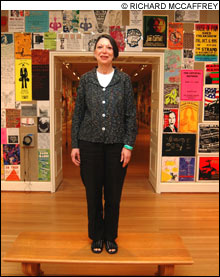
WHOLE LOT OF HISTORY: With local artists, Tannenbaum conceived the idea of displaying a decade’s worth of posters documenting the Providence look.
|
Although Wunderground: Providence, 1995 to the present, an exhibition opening this Friday (from 7-10 pm) at the Rhode Island School of Design Museum, encapsulates a very brief period of time, it also represents a dramatically compressed cycle of change in the life of the city.
Eleven years ago, the availability of cheap mill space enabled a youthful cast of anti-materialistic artists to create Fort Thunder, their own wildly fertile alternative to mainstream consumer culture. Yet within just a few years, amid growing national hype about the so-called Providence Renaissance, the low-rent accessibility that helped fuel this influential scene was rapidly disappearing.
When an out-of-town developer planned a bland suburban-style strip mall on the site encompassing Fort Thunder, the ensuing battle highlighted sharply divergent visions for Providence’s future. Despite broad opposition, the shopping complex came to fruition, initiating a wave of new development extending from the rear of the Providence Place Mall to Olneyville Square. And though the battle served as a distinct wake-up call, the City of Providence still struggles with the question of how to help ensure a place for the underground artists who have lent the city creative cache far and wide, particularly through noise music, screen-printing, and comics. This scene continues, though, thanks in part to the devotion of its members to their adopted home.
In this respect, Wunderground represents a look at past and present. One element of the show presents more than 2000 posters promoting subterranean art and music events. The other part, a towering sculptural village created by eight artists representative of the Providence underground, is titled Shangri-la-la-land. The title, chosen by the participants, suggests the kind of utopian ideals associated with art collectives like Fort Thunder, as well as the uncertain tenor of the current moment. One piece, Brian Chippendale’s wheeled Home on the Run, seems a riff on how he’s repeatedly been displaced by development.
The Phoenix (which is the media sponsor for Wunderground) recently sat down to discuss the show with Judith Tannenbaum, the RISD Museum’s Richard Brown Baker curator of contemporary art.
Tell me about why RISD decided to take on this show.
I was aware of a number of artists who live here, whose contribution is known outside of the region -- and it’s known within a certain part of the community here -- but it’s still not really visible or available to a lot of people who go to museums or like to see art. One of the reasons why I was interested in organizing the exhibition was to make that work more available, and a lot of the artists did train at RISD, so there is a particular connection to the school in that way.
ADVERTISEMENT
 |
What do you find most distinctive about the art and music highlighted by this show?
Perhaps it’s the overlap between the art and the music. The posters were done to publicize, to let people know that music events were happening in the community. I think the style of the posters developed over a period of time, in the same way that the music did.
I’m not as knowledgeable about the music myself, but I did ask somebody about what they thought the relationship between the art and the music was, and they used as an example Brian Chippendale and Lightning Bolt. The same way that he uses these very repetitive dot patterns is, in a way, related to the layering that he uses in his music, and that to me is very interesting. So I think that’s something that deserves to be looked at even further.
How receptive were the artists to taking part in this show, and how did you or the museum go about reaching out to them?
I felt that the show would really have to be generated to a large degree by the artists who we invited to work here. So I brainstormed with a few people and came up with a group of about eight artists who we invited to have a meeting and talk about the possibility of doing an exhibition. And to our great delight, all eight of them thought that it was an interesting idea. So we really went from there.
At the first meeting, I think, we came up with the idea of the poster show. The artists were really interested in the idea of seeing all together as many of the posters that have been produced here in a 10-year period, starting in 1995 when Fort Thunder and some of the other collective spaces were in their infancy. And to start that in the year we actually started [working on] the show was 2005, and I think that’s why we decided to go up to that point. Then in conjunction with that, I really encouraged them to think about doing something new for the museum and to create new work. So we looked at the places, we had to figure out which parts of the museum would work best to have an exhibition here and how to organize both of those projects.